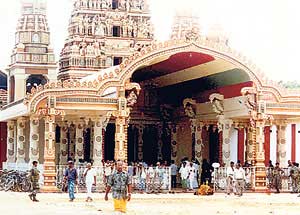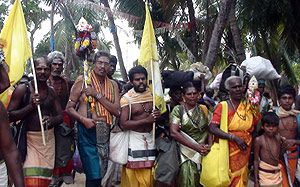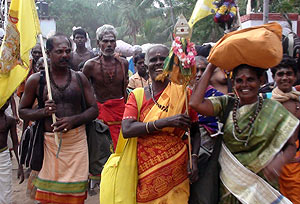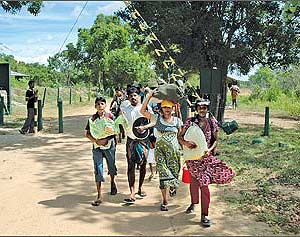
|
|||||||
|
| |||||||
 Growing numbers of Pāda Yātrā pilgrimsEarnest devotees of Kataragama by the thousands—hailing from all communities but especially Tamil Hindus—are now undertaking the annual Pāda Yātrā or foot pilgrimage through Yala National Park to Kataragama for this month's Esala festival that commenced on July 12. With decades of fear and uncertainty swept away, this year more devotees are walking than at any time in living memory, possibly even more than in 2004 when Wildlife Department officials counted over 30,000 pilgrims entering Yala East National Park on the final 70-kilometre stretch from Okanda to Kataragama. The first waves of pilgrims from all up and down the east coast have already arrived to Okanda Murugan Kovil in Yala East where tens of thousands are pausing to rest and worship before entering Yala Strict Natural Reserve on the long jungle trek to Kataragama. The Kataragama Pāda Yātrā traditionally starts from points in the Jaffna peninsula like Nallur and Selva Sannidhi Murugan kovils, from where the pilgrimage may take up to two months to reach Kataragama. This year for the first time since 2005, a few souls are walking the full distance, joined along the way by a few more from Kilinochchi, Mullaitivu, and Trincomalee districts. The ones who walk from afar are those who savour the traditional pilgrim's life of sleeping in temples and under the open sky, accepting whatever alms that strangers may offer, and bearing up under scorching sun while walking barefoot on searing hot roads, clad only in simple pilgrim's garb with a small bundle of offerings and belongings balanced upon their heads. All along the way, villagers await their chance to offer dāna to the small bands of swāmis and swāmi ammas. For many pilgrims the Pāda Yātrā is the chance of a lifetime to visit ancient shrines all the way to Kataragama in the company of veteran devotees. Their long trek takes them to famous temples at Sittandy, Mamamgam, Kaluthavalai, and Mandur in Batticaloa District. In Ampara District they follow the coast via Tirukkovil, Pottuvil and Okanda through Yala National Park to reach Kataragama. Some pilgrims may carry the Kataragama God's bright red and yellow cock banner. Others wave peacock feathers, while senior swāmis bear aloft the Vel or lance, symbol of the God's invincibility. Even children dressed in vetti may be seen accompanying their grandmothers, shouting ‘Haro Harā!' (‘Hallelujah'), and joining in the constant recital of bhajans in praise of God Kataragama. Pilgrims sleep under the stars at night or in temples, but never in private homes. Consumption of alcohol is strictly prohibited. Elder pilgrims especially enjoy the respect of villagers and pilgrims alike, who consider them as treasuries of age-old traditions. Many villagers take vows to join the Pāda Yātrā as it passes through their own village, so the parties of pilgrims tend to grow as they move from village to village. Traditional pilgrims are easily recognized by their authentic pilgrim's attire: vettis and shawl for men, saris for women, and all go barefoot singing as they walk southward. Trousers, shirts, or shoes are considered unacceptable attire for pilgrims. The Kataragama Devotees Trust (www.kataragama.org) has annually organized the Pāda Yātrā by notifying devotees, societies and temples all along the East Coast. This facilitates the planning for dāna, the ritual offering of food that is essential to the pilgrims, since most are poor villagers and none can carry provisions for weeks. The Kataragama Pāda Yātrā tradition has been making a slow comeback after facing near-extinction following the 1983 civil disturbances. With the birth of the Kataragama Devotees Trust in 1988 and subsequent efforts to revive the foot pilgrimage tradition, pilgrims began to join by the hundreds in the mid-1990's. On June 19, a large group of pilgrims assembled at Verugal Murugan Kovil on the border of Trincomalee and Batticaloa districts and set out on the annual karai yāthirai or coastal pilgrimage to Lord Kataragama Skanda's great shrine. They are the Ādiyār Kūttam, the oldest kūttam (pilgrim's circle) walking from as far as Selva Sannidhi annually since 1988. This year they are led from Verugal by Maheswara Swami of Karaitivu, accompanied by a host of colourful swāmis and swāmi ammas, as well as young people and even whole families. Despite the Pāda Yātrā's burgeoning popularity in recent years, old-timers lament the fading away of the old swāmis and swāmi ammas, and with them the ancient practices and knowledge that they kept alive. Whole families, youth groups and even NGOs now pack up and race by vehicle to Okanda, where they alight and walk, often dressed in outlandish attire and outfitted with the luxuries of home, as if going on a picnic. And yet, amidst the throngs of town dwellers clad in shoes or bata slippers, one may also find the occasional kūttam led by veteran pilgrims who not only know the paths and the halting places, but also recall the old songs and stories associated with the Pāda Yātrā. Many try to preserve the traditions and practices that they have seen and heard of. Oddly enough, government officials charged with serving the Pāda Yātrā pilgrims pay far more attention to the well-heeled and well-dressed pilgrims than to those who are genuinely preserving the Pāda Yātrā's traditions. Yet another instance of ‘the blind leading the blind'! Many pilgrims have already reached Kataragama for the July 12 flag hoisting ceremony. Most will remain for three days only, camping out in the open long enough to complete their vows by bathing and offering milk rice at Sella Kataragama before climbing Kathira Malai (the ‘Mountain of Light'), as Vedisitakanda (‘The Peak Where He Was') is known to Tamil devotees. Their vows completed, foot pilgrims return home by vehicle like other pilgrims. Nowadays in countries like India, religious processions and pilgrimages are sources of communal friction. But the Kataragama Pāda Yātrā remains a source of consensus and communal harmony, a fact that Sri Lankans may rightly reflect upon and be grateful for. Patrick Harrigan has walked the Kataragama Pada Yatra twenty times since 1972. Courtesy: The Sunday Times of Sunday, July 18, 2010 Nallur festival: Western attire bannedBy N. Parameshwaran
Western attire has been outlawed for this year's Nallur Festival in the Jaffna Peninsula and pilgrims have been told that only the traditional saree or long skirt and full blouse for women and the verti for men will be allowed. Nallur Kovil comes up with a dress code. Jaffna Mayor and festival's Organizing Committee chairperson Yogeswari Patkunarajah told the Sunday Times the decision was taken since a large number of expatriate Tamils were visiting the peninsula in Western attire that was not in keeping with the Tamil culture of the area. "Skirts will be allowed provided they are way down to ankle length and blouses that cover the entire upper part of the body," Ms. Patkunarajah said. The popular churidar (salvars) worn by women had also been banned, she said. The dress code will be communicated through notices in Sinhala, Tamil and English to bring about awareness among pilgrims from the south and other parts of the country. The festival which is likely to attract hundreds of thousands of people from all parts of the country and overseas begins on August 15 and will go on for 25 days. Courtesy: The Sunday Times of Sunday, July 18, 2010 Kataragama.org |
|
| Living Heritage Trust ©2023 All Rights Reserved |



